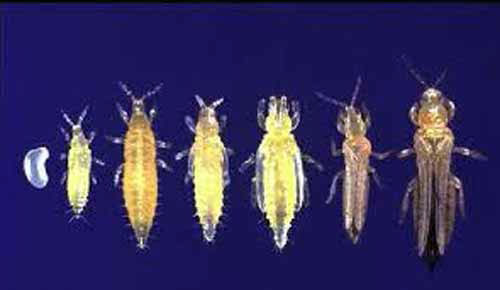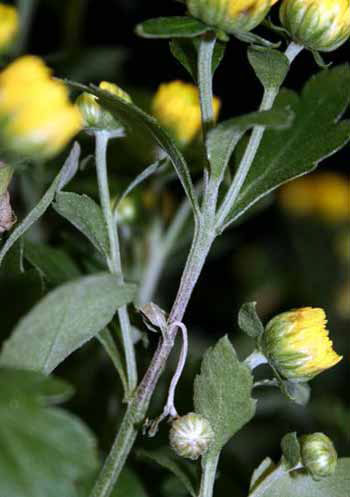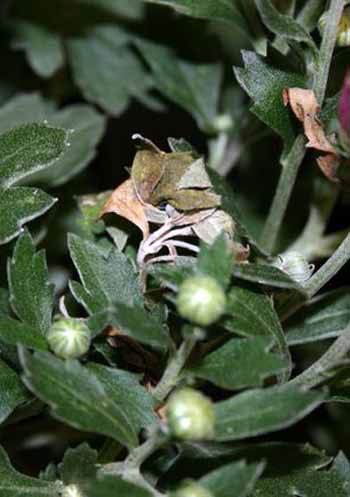Growers of fall garden mums need to inspect and test for tomato spotted wilt virus now
By inspecting and testing fall garden mums now, growers can avoid problems later this summer and fall. Recognize tomato spotted wilt virus symptoms and thrips control strategies.
Growers of fall garden mums need to be checking all incoming cuttings for symptoms of tomato spotted wilt virus (TSWV) now and/or do some in-house testing or send samples to the MSU Diagnostic Services lab. Last summer’s outbreak of this virus was detected too late to save some plants. Michigan State University Extension advises growers to be proactive now to be able to reduce the risks to their crops. The following article was updated for the 2014 season.
Thrips can be a major pest of fall garden mums during the summer months. Michigan State University Extension advises growers to be aware that thrips are the vector for tospoviruses like tomato spotted wilt virus, impatiens necrotic spot virus and iris yellow spot virus.
Tomato spotted wilt virus has one of the largest host ranges of any plant virus, affecting both dicots and monocots. It infects more than 800 plant species with more than 80 plant families. In the past few weeks, tomato spotted wilt virus was found in a crop of greenhouse-grown fall mums.
Thrips vector the virus
Western flower thrips (Frankliniella occidentalis), onion thrips (Thrips tobaci) and tobacco thrips (Frankliniella fusca) are the three primary species to vector tospoviruses in Michigan. The Western flower thrips are the most common pest found in greenhouses during spring production of bedding plants. However, with the heat of the summer, greenhouses utilize passive and active venting that allows the entry of the other thrips species.

Photo 1. From left to right; egg, two instars, two pupae, female adult and male adult. Photo credit: UC-Davis
Thrips are known to have high fecundity (productive reproduction ability) and short reproductive cycles. Western flower thrips can take as little as 10 days to complete a lifecycle. The life stages consist of egg, two larval instars and two pseudo-pupae stages (where the thrips do not feed), and adult. The larval feeding stage acquires the virus while puncturing the plant cells and feeding on the cytoplasm of infected plants.
Western flower thrips has two modes of feeding. They probe for a short duration while they salivate into the plant cells, spreading the virus and causing plant damage. Or less often, they puncture the cells and feed for long periods of time. It is documented that the Western flower thrips adults can only spread the virus if the virus was acquired while in its larval stage. The virus is stored in the mid-gut and passed through the papal stage into the adult stage.
Control of Western flower thrips is essential in reducing the spread of the tomato spotted wilt virus in your mum crop.
Managing the thrips population is imperative in preventing tomato spotted wilt virus spread. It is important to monitor thrips levels throughout the production cycle in adjacent crops as well as in the mum crop.
The thrips lifecycle is such that insecticide spray treatments need to be every five days when temperatures are above 80 degrees to prevent rapid buildup in your greenhouse or outside growing areas. Getting through coverage with a “high pressure” sprayer is essential, as thrips like to hide in the plants and may not come in contact with the spray materials if you use another type of delivery system.
Western flower thrips are also known to have developed resistance to many of our insecticides we have used in the past. MSU Department of Entomology’s David Smitley recommends using the following insecticides and rotating chemical classes so you do not use a product from the same chemical class more than three consecutive times.
- Aria
- Distance
- Hatchi-Hatchi
- Mesurol
- Orthene 97
- Overture
- Pedestal
- Pylon,
- Sanmite
Tomato spotted wilt virus
Symptoms of tomato spotted wilt virus on mums can be easily confused with those caused by fungal pathogens. Growers need to be aware of the symptoms in order to scout effectively. Symptoms can develop on the leaves, stems and flower buds of mums. The leaf tissue may have yellow rings or ring patterns that become necrotic. The stems of infected plants show a grayish canker (Photo 2), causing the stem to collapse and fall over (Photo 3).


Photos 2-3. Left, Stems of infected plants show a grayish color. Right, Infected plants will cause the stem to collapse and fall over. Photo credits: Jan Byrne, MSU
Growers can purchase in-house test kits for use in their production facility or can send plants to MSU Diagnostic Services for testing. Identifying infected material is an important step in disease management. Once a plant is infected, there are no curative chemical treatments. Infected plants left in the greenhouse can serve as a source of inoculum from which thrips can acquire the virus. Plants that test positive for tomato spotted wilt virus should be removed from the production area and destroyed.
We also recommend sending in samples of plants to a diagnostic lab, such as MSU Diagnostic Services, to have third party documentation of your results should you need it in the future for any settlement issues with your supplier.
Special thanks to former MSU Extension educator Jeanne Himmelein, whose original article on this topic helped to lay the groundwork for this current article.



 Print
Print Email
Email


